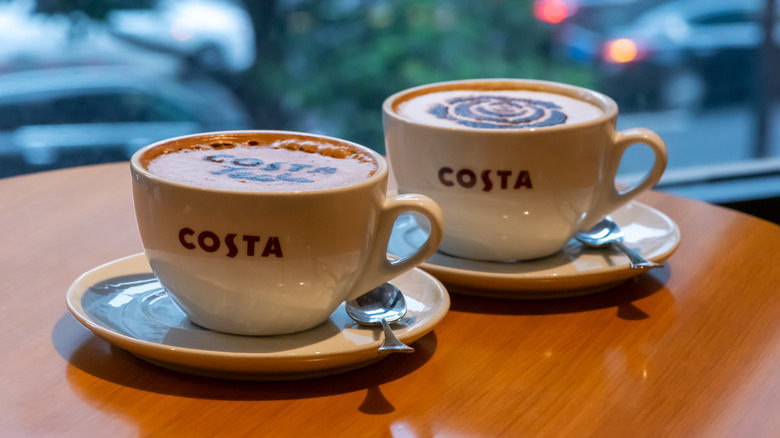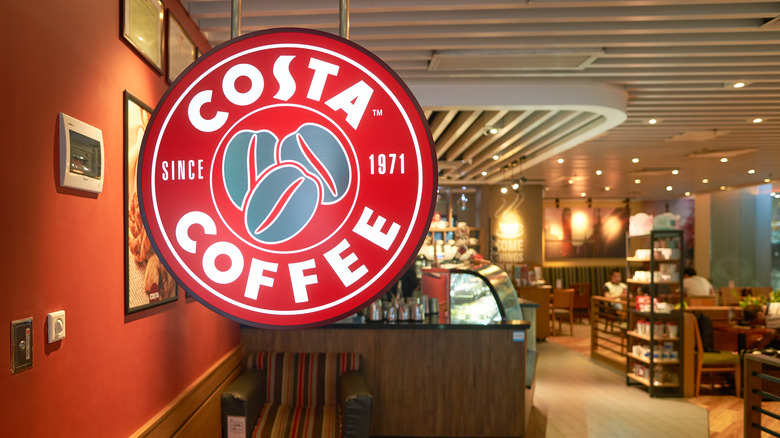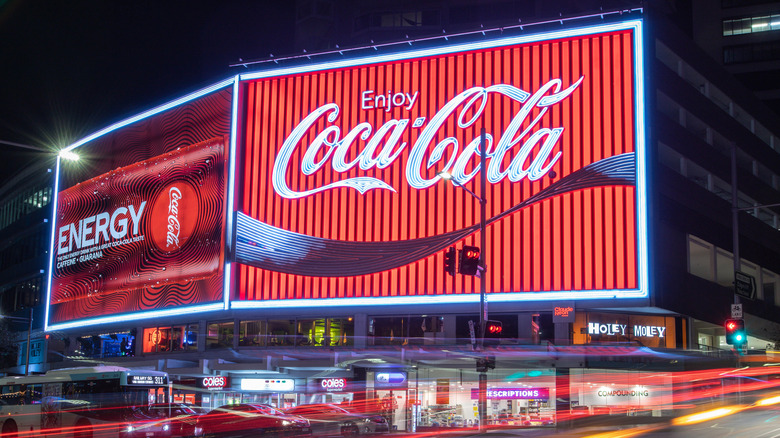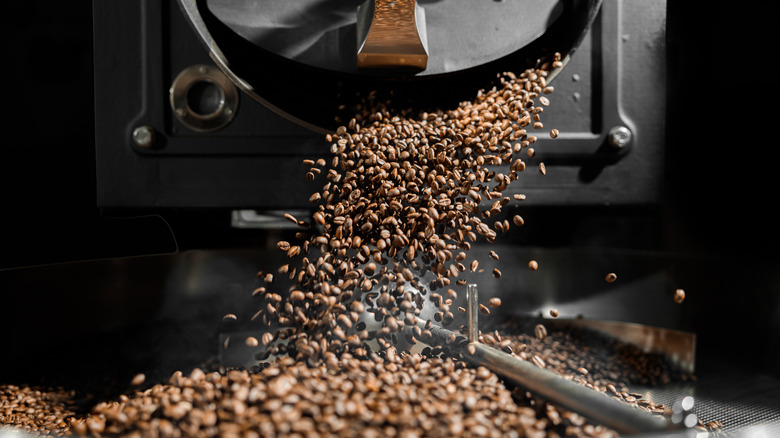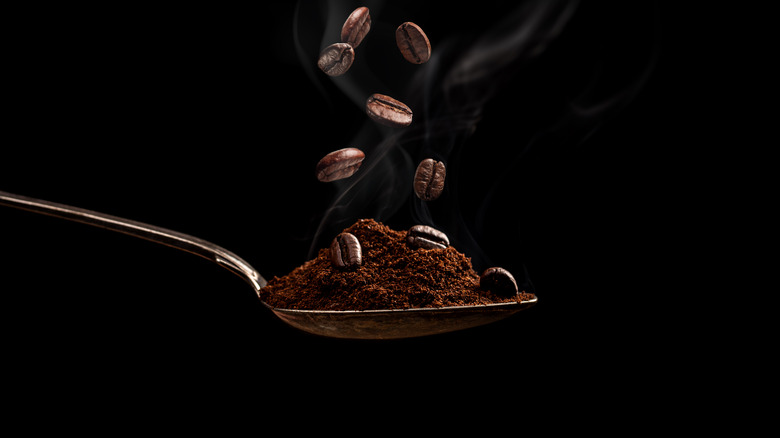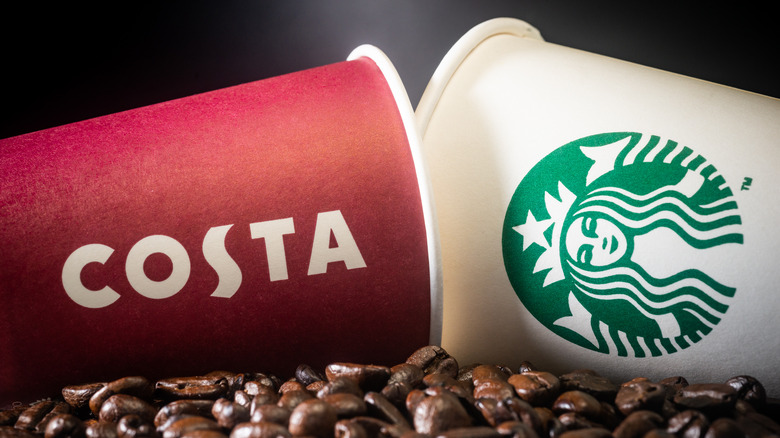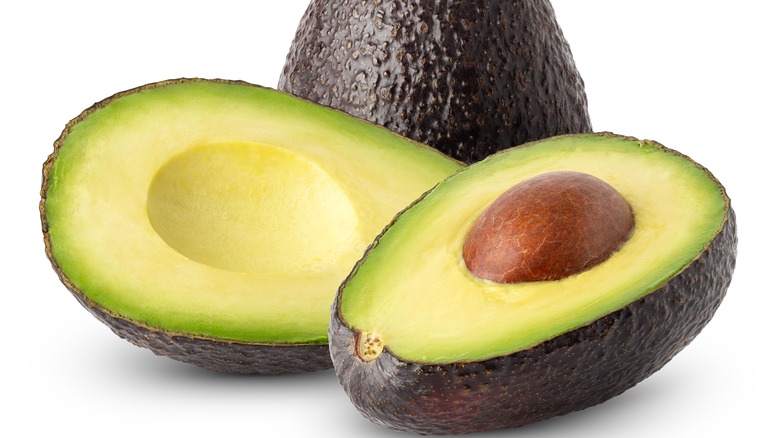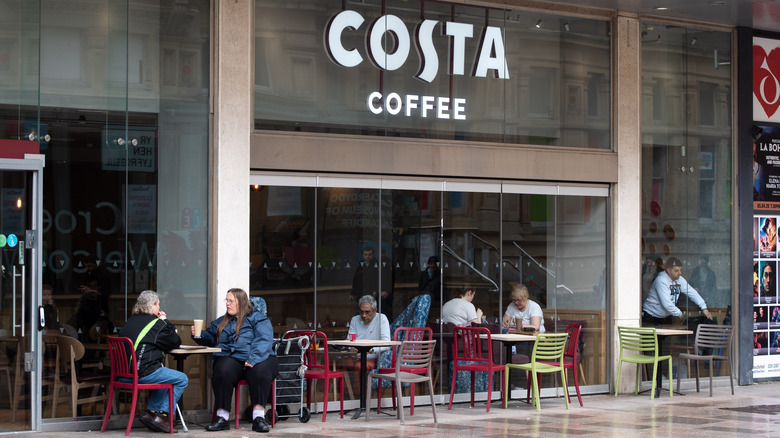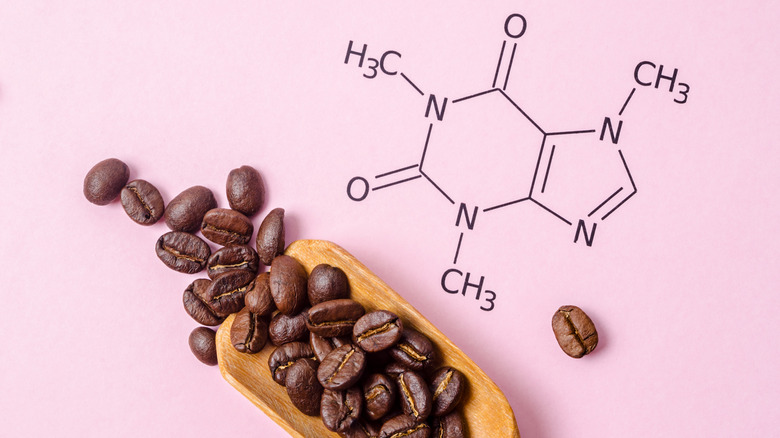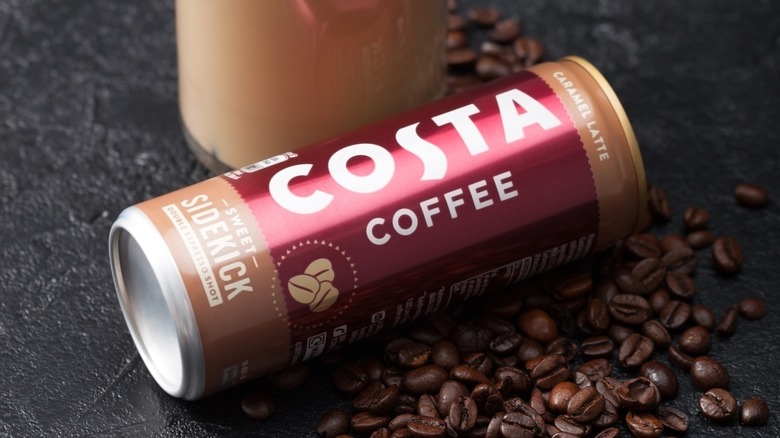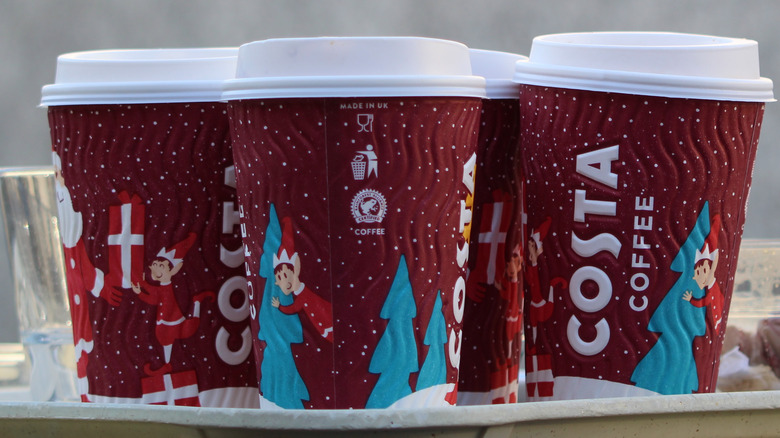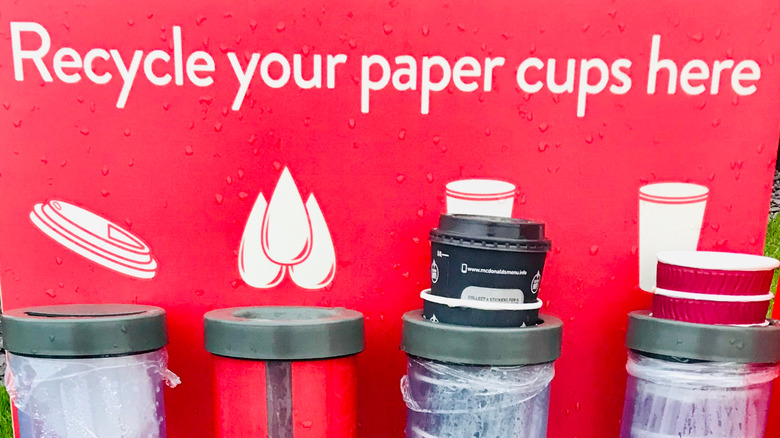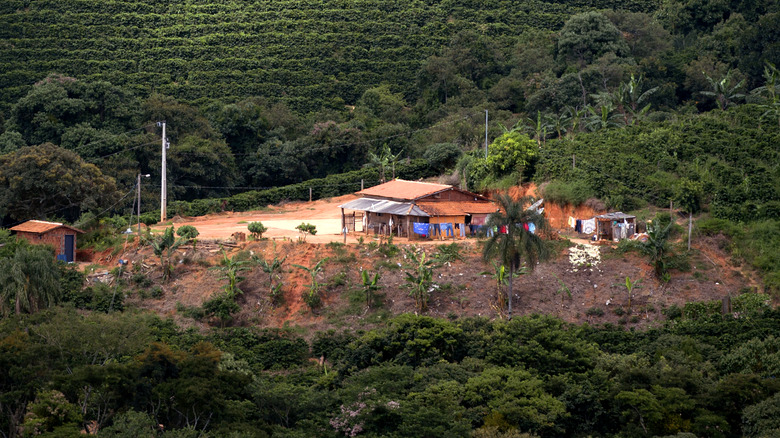Everything You Need To Know About Costa Coffee
With an abundance of brands to choose from, finding an outstanding coffee producer can sometimes seem like a daunting task. Perhaps you prefer to brew your beans at home or maybe you favor the social commodity of buying a fancy beverage from a coffee shop. Whatever the case, it's always good to know where your coffee comes from and remain informed about all of your available options, especially if you're traveling. Enter Costa Coffee.
Though virtually unknown in the U.S., over the past 50 years the company built a reputation as the leader of the U.K. coffee market niche. Founded in 1971 by Italian-born brothers Sergio and Bruno Costa, Costa Coffee stemmed from the wish to make quality, good-tasting coffee available to any coffee enthusiast in England. And, as the company's history shows, it managed to do exactly that while adding a bit of flair to its wide-ranging beverage and food menu. Here is how the company grew over time and what presently sets it apart from its competitors.
Its signature blend took a lot of effort to perfect
Costa Coffee is one of the best-known international brands with a one-of-a-kind flavor that is deeply rooted in its history. The main purpose of the brand founded in London in 1971 was to develop a unique, well-flavored coffee and make it available to its customers. The Costa brothers knew a thing or two about coffee and wanted to share this expertise with the British public. They tested 112 coffee mixtures to find Costa's signature blend (via Costa Coffee).
In a few short years, the brand became well-known in London, and the brothers opened the first Costa roastery in 1978. Costa Coffee's early business model meant selling its product to restaurants and hotels. The company's style included a touch of class, as it made deliveries using London's iconic black cabs. Three years later, in 1981, Costa opened the first Costa Coffee shop in London. The company kept the same classy image, serving coffee in fancy porcelain cups.
Another important landmark in Costa Coffee's history was the 1995 acquisition by the international hospitality company Whitbread. With Whitbread, Costa Coffee grew from having 39 coffee shops to being the most important coffee shop company in the U.K..
Coca-Cola acquired Costa Coffee in 2019
According to Forbes, Coca-Cola acquired Costa Coffee to expand in the hot beverage (coffee) segment, as the coffee company had very good worldwide prospects. The acquisition was announced by both Coca-Cola and Costa Coffee's parent company, Whitbread, in 2018. It effectively took place in the first half of 2019, for a reported $5.1 billion (via Coca-Cola).
As a consequence, Coca-Cola expanded into a constantly growing niche. Coca-Cola benefits from Costa Coffee's coffee expertise, from sourcing to distribution, and can expand the company's offer. The acquisition was another recognition of Costa's brand presence and international growth potential. On the other hand, the Costa Coffee brand gained the marketing and distribution capabilities of a massive international company.
Also, with Coca-Cola's brand awareness and marketing channels in Asia, Costa Coffee was able to take root in China, one of the fastest-growing economies. For the Costa Coffee brand, this would be the next step to becoming an international powerhouse.
Costa's roastery uses state-of-the-art technology
It's obvious that a coffee brand knows its trade when the picking, roasting, and mixing of its beans are all done in-house. Costa Coffee has long owned its roastery, but in 2017, a year before announcing the Coca-Cola acquisition, it opened one of the largest roasteries in Europe. Located in Basildon, Essex, U.K., the roastery represents an investment of $48.66 million and the location was chosen for its proximity to Tilbury Port, the place where the raw coffee beans used by Costa enter the country.
The roastery is designed to produce 45,000 tons of coffee a year, a figure that represents four times more than the roasting capacity of the previous roastery, according to Costa Coffee. A single-story production unit, the Basildon roastery was built using sustainable materials and technologies and is equipped with a rainwater harvesting system and a solar photovoltaic system. The improvement of processing methods and the use of new technologies means that productivity has increased by 25% (via Food Processing Technology). The roastery is also home to a training academy, where 3,000 baristas can be coached every year.
Its Master of Coffee had his tongue insured by Lloyd's
If you've ever tasted coffee, you know that the flavors can vary a great deal and the taste can make it or break it. To guarantee the best quality of its coffee beans, Costa Coffee's Master of Coffee, Gennaro Pelliccia, had his tongue insured by Lloyd's of London in 2009.
According to The Telegraph, the insurance covered £10 million ($13.78 million). In an interview with Singapore's Today, Pelliccia mentioned that most members of his family have worked for Costa Coffee. He began working there as a barista when he was 16, then, after several other jobs within the company, was certified as an "Italian espresso taster" by the Institute of Italian Coffee Tasters in 1999.
According to Pelliccia, the insurance policy was the result of an independent survey commissioned by Costa Coffee that proved that "seven out of 10 people preferred Costa's cappuccino." So, the company used the insurance at Lloyd's as publicity. Of course, this marketing strategy proved to be very effective, and it remained a highlight in the company's history, helping boost sales ever since.
Costa used an ad campaign to troll Starbucks
When Costa Coffee launched its first national advertising campaign in 2009, the brand knew it had to make waves. And what better method to use than to attack the biggest competitor in the coffee market — Starbucks?
According to The Guardian, the advertising agency Karmarama designed posters with texts such as "Sorry Starbucks: the people have voted" or "Starbucks drinkers prefer Costa," references to a 2009 study that determined coffee drinkers preferred Costa's cappuccino. Starbucks filed a complaint to the Advertising Standards Authority, accusing Costa Coffee of using "misleading ads, a flawed methodology, and a small print that was not sufficiently legible" (via Marketing Week).
The Advertising Standards Authority dismissed all accusations, as they found no issue of a misleading message or a flawed research methodology. The ASA also ruled that people with normal eyesight had no problem reading the small print messages which explained the research. As a result of the counts being cleared, Costa Coffee was allowed to continue using the ads.
The company got into trouble for mocking avocados
In 2018, Costa rolled out a radio ad promoting hot bacon rolls and egg muffins. The ad followed the same aggressive stance as the 2009 anti-Starbucks posters. This time the focus was on the downside of buying fresh avocados and presented Costa's food options as superior and easier to consume.
The Advertising Standards Authority received two complaints about portraying fresh fruit in a negative light. Specifically, Costa mocked avocados for the extended time they take to ripen and the short window for consumption once the creamy green toast companion is ready to eat.
The Advertising Standards Authority found that in comparing their products with fresh fruit, Costa Coffee broke rule 13.5 in the U.K. Code to Broadcast Advertising. This is a legal document stating that no advertisement should discourage the selection of fresh fruit and vegetables. The aftermath of ASA's decision was that Costa Coffee was banned from using the ad in that form and asked by the authorities to focus on positive eating habits in their future ads.
The Costa menu caters to a wide range of diets
Perhaps as a result of the issues the company had with the ASA, Costa Coffee is now dedicated to offering healthy options in both its beverage range and food products. The company took certain steps meant to improve the quality of their drinks and food and to lower calorie and fat counts.
For instance, the Costa Coffee website offers advice for healthier ordering in its coffee shops, highlighting plant-based and low-fat and alternatives to whole milk. Other suggestions include ordering a smaller size, choosing sugar-free syrups or no syrup at all, and replacing sugar with alternatives such as Stevia.
To raise awareness regarding the nutritional value of the products, Costa Coffee also discloses all nutrition and allergens information in its online menu. The selection tool in the menu allows customers to select certain features of the products, such as dairy-free, soy-free, and vegan. Also, you can download a PDF file containing nutritional information for every Costa Coffee product, which lists the ingredients, allergens, and nutritional values of the product (calories, fats, carbohydrates, salt, and more).
Its drinks contain more caffeine compared to other brands
The Journal of Food Science reports that 80% of all people on Earth have at least one caffeinated beverage a day and that number rises to 90% for adults in the USA. But if you're looking for an extra jolt of energy to start the day (or, perhaps, keep it going), you may want to consider making Costa your coffee brand of choice.
According to a survey by Caffeine Informer, the amount of caffeine in an average Costa Coffee beverage is among the highest on the market, well above that of its competitors. A Costa Coffee small espresso has 92 milligrams of caffeine whereas the Starbucks tall espresso has 75 milligrams. However, most of the coffee-based beverages sold by Costa have double or triple caffeine amounts as they contain two or three espressos. So, there's no doubt that a Costa coffee will keep you awake and energized.
Costa offers a line of ready-to-drink products
A very important step in increasing the diversity of Costa Coffee's products was achieved with the introduction of ready-to-drink coffee options. Coca-Cola announced the launch of the product line in a 2019 press release. These are bottled versions of many popular Costa Coffee drinks, made with the Rainforest Alliance Certified Mocha Italia Signature Blend espresso (double shot) and milk. There are many available options for ready-to-drink Costa beverages. Among them are the double shot espresso flat white, the lattes (simple, caramel, and vanilla, in small or big servings), and the frappes (smooth coffee, choc fudge brownie, and the caramel swirl).
While Costa ready-to-drink products are available in many shops across Europe and China, they have yet to make their way over to the U.S. However, the company does offer a wide selection of coffee beans (whole, ground, and in single-serving pods) to stateside customers.
Expect new offerings during the holiday season
The Costa Coffee Christmas menu is a collection of products that encapsulate the joy and taste of the holidays. Several seasonal drinks and bites have become a staple of the company over the years, such as the Purple One Latte, Toffee Penny Latte, festive toasties, sausage rolls, and paninis.
The 2021 Costa Christmas food menu offered a wide variety of both savory and sweet items. Items included Maple Glazed Pigs in Blankets Potato Chips, British Turkey & The Trimmings Toastie, and the Festive Pork and Bramley Apple Sausage Roll. For those with a sweet tooth, Costa offered desserts such as a Florentine Mince Tart and Winter Frosted Marble Cake.
As for drinks, the Purple One remains the undeniable hit of Costa's Christmas menu. A latte that promises to replicate the taste of Quality Street Chocolates, it blends caramel chocolate sauce and roasted hazelnut syrup. It's like candy in liquid form, with all the flavors complementing each other. With a silky texture, a subtle coffee taste, and a sweet, feel-good quality about it, the Purple One is a magical taste of the holidays.
The company is environmentally conscious
In an effort to protect the environment, Costa Coffee is dedicated to using sustainable materials, reducing waste, and recycling. The single-use coffee cups used by Costa are made with 95% sustainable wood fiber and 5% plant-made renewable lining. Also, the iconic red waffle wrap used on the cups makes the cardboard sleeve obsolete, as it provides insulation. The Costa Coffee cup used for cold drinks is made with 60% recycled plastic, and the ready-to-drink cans are made with 75% recycled aluminum.
Furthermore, to promote recycling, Costa introduced recycling points in all the stores in the U.K. Another step taken by the company to protect the environment is represented by reusable cups. During 2022, Costa tried out a reusable cup scheme in 14 coffee shops in Glasgow. The trial meant that customers could borrow a cup, use it, and then leave it at the store when they were done so that it could be cleaned and further used. The company is now looking for ways to implement this process on a larger scale.
Costa offers support to coffee-growing communities
Given that all the coffee beans are sourced from communities located in the so-called "coffee belt" (via Coffee Affection), Costa Coffee has become socially involved in education and social projects in these areas. Partnering with local organizations and institutions, such as Federación Nacional de Cafeteros de Colombia or PEAS in Uganda, the company supplies long-term support for the communities that grow coffee. The financial support is used for building schools, extending school buildings, or equipping schools with computers.
Through Costa Foundation, the company helped build more than 100 schools in Colombia, Ethiopia, Guatemala, Honduras, Nicaragua, Peru, Uganda, Vietnam, and Zambia. The Foundation funded teacher training and accommodation, the acquisition of computers, and access to electricity and water supplies. It also helped communities that supply coffee beans to grow their crops and improve their living standards, by building latrines.
Like any charity, the Costa Foundation promotes its activities. One way of doing this is the "Foundation Friday" event, which takes place on the last Friday of every month in Costa Coffee Stores. From 2007, when the foundation was created, to 2017, the institution has donated over £9.4 million ($11 million), as declared by Costa Foundation's manager, Piers Blake (via Fundraising Magazine).
